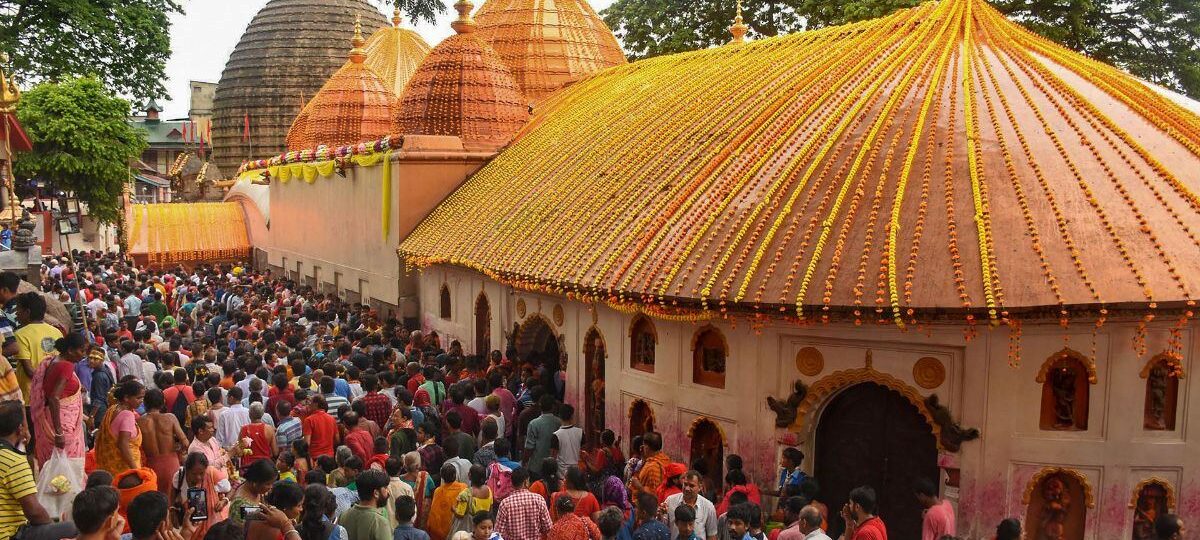The Ambubachi Mela at Kamakhya Temple in Guwahati, Assam is one of the most famous spiritual festivals globally. During this time, people from all over the country come to offer prayer to Goddess Kamakhya Devi and take part in special holly rituals and spiritual events. It is believed that the energy in the Kamakhya temple becomes very strong during the Mela, helping people feel closer to the Goddess and share their wishes with her. This festival is also seen as a time when Mother Nature is full of life and fertility, symbolizing new beginnings and growth.
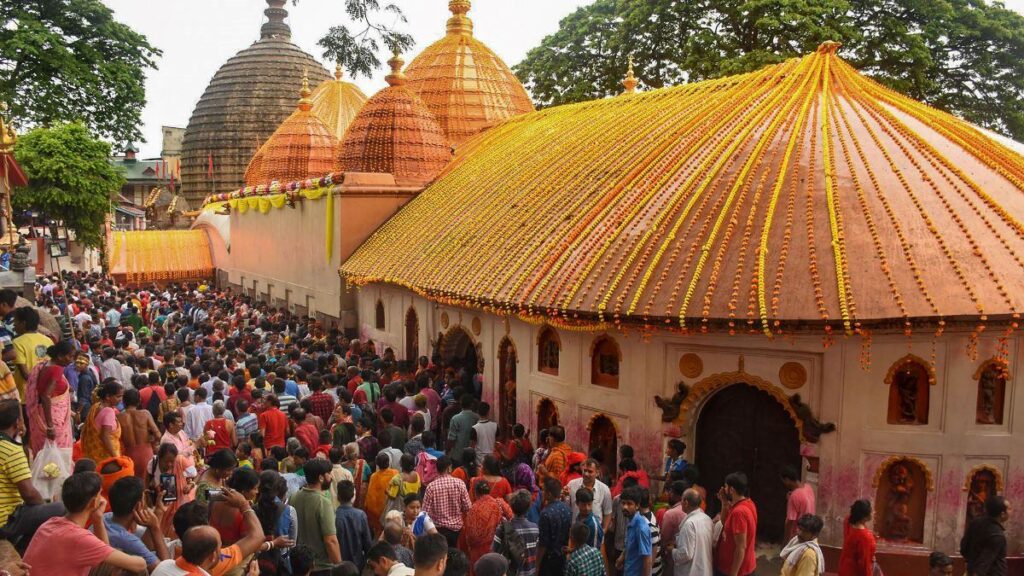
Through this blog, we will be seeing how spirituality this period is in this region, and what Ambubachi Mela is exactly, getting to know closer what it actually signifies.
History of Ambubachi Mela
The story behind the Kamakhya Temple is deeply rooted and connected to the tale of Goddess Sati, and it is this powerful legend that makes the Mela so special.
Sati was the beloved daughter of King Daksha, a strong devotee of Lord Vishnu. He often held grand yajnas and rituals in Vishnu’s honour and tp please him. However, Sati had a different spiritual path and was drawn to Lord Shiva and loved him deeply. She eventually won his heart and married him, even though her father was against it. King Daksha disliked everything about Shiva be it from his wild lifestyle to his unusual appearance and his habit of visiting cremation grounds. Despite all this, Sati chose love and moved to Mount Kailash with her husband.

One day, King Daksha arranged a grand yajna and invited everyone but Lord Shiva, his son-in-law. Sati still wanted to attend, even though Shiva advised her not to go. Ignoring his words, she went to the event, only to witness her father insulting Lord Shiva in front of everyone. This broke Sati’s heart. She realized her father never cared for her feelings but only wanted to insult her husband. Full of pain, anger, and guilt, Sati invoked her inner shakti (fire) and gave up her life by jumping into the sacred fire.
When Lord Shiva heard that his wife Sati had given up her life, he was overcome with unbearable grief and uncontrollable anger. In his rage, he took the form of Veerabhadra, a fierce warrior, and went to King Daksha’s yajna. There, he beheaded Daksha for insulting Sati and causing her death. Holding Sati’s lifeless body in his arms, Shiva began the Tandava—the cosmic dance of destruction—which shook the balance of the entire universe.
To stop the destruction and restore peace, Lord Vishnu had to intervene. He released his Sudarshan Chakra, a divine spinning disc, and cut Sati’s body into 51 pieces. These pieces fell in various parts of India and nearby regions. Each place where a piece fell became a sacred site known as a Shakti Peetha.
The Kamakhya temple in Assam is believed to be the spot where Sati’s womb fell. That’s why it is considered one of the most powerful Shakti Peethas. This connection to Goddess Sati’s story makes the temple deeply spiritual, and during the Mela, devotees from far and wide visit Kamakhya temple to honour her divine power. The Ambubachi Mela celebrates this powerful energy and is a reminder of both sorrow and strength, destruction and creation.
This is why the Ambubachi Mela at Kamakhya Temple is not just a religious event here, but a celebration of the divine feminine power. The Mela is believed to mark the yearly menstrual cycle of Goddess Kamakhya, symbolizing Mother Earth’s fertility and strength. During this time, thousands of devotees gather at the temple to witness this ancient story and seek blessings from the Goddess. The Mela reminds everyone of the powerful legacy of Sati and the sacredness of the Kamakhya Temple.
Why is Ambubachi Mela celebrated?
The Ambubachi Mela is a unique and sacred festival celebrated every year at the Kamakhya temple in Guwahati, Assam. People from all over the country come here to be a part of it. But why is it celebrated? The Ambubachi Mela marks the yearly menstruation cycle of Kamakhya Devi, who is believed to be the goddess of fertility and power. Just like every woman rests during her period, it is believed that the goddess also rests during these days.
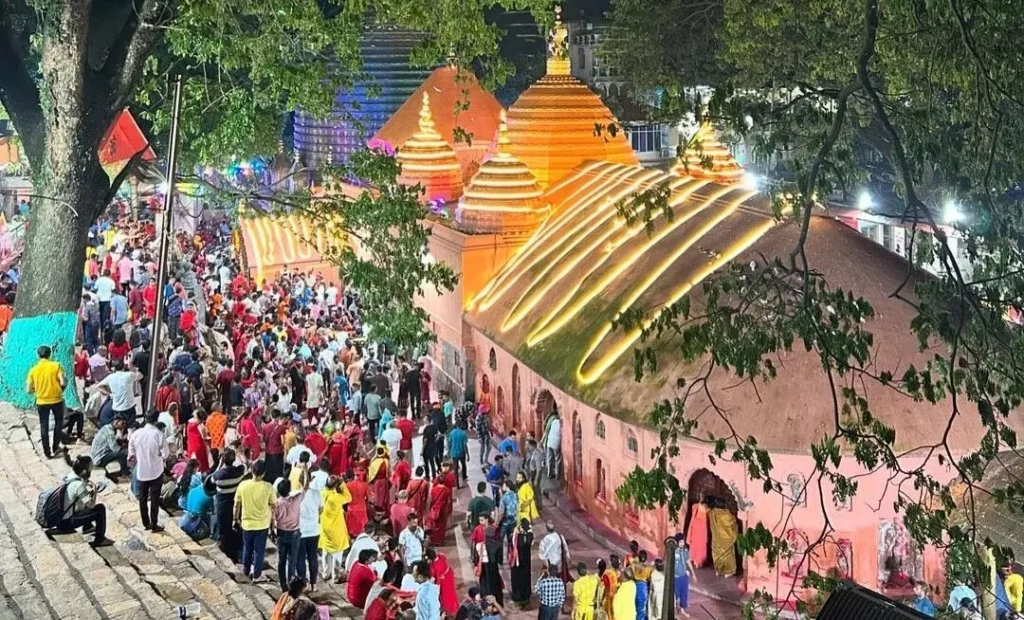
The temple remains closed for three days, and no worship or farming is done, as it is considered a time of nature’s pause. On the fourth day, the temple doors open again, and thousands of devotees rush in to seek blessings. It is more than a religious ritual — it’s a celebration of womanhood, fertility, and nature’s power.
The Ambubachi Mela 2025 will be no different. Lakhs of sadhus, saints, and common people will gather again at the Kamakhya Temple. In 2025 it is expected to be even grander, filled with spiritual energy and devotion. For many, the Ambubachi Mela is not just an event — it’s an emotion, a connection to the divine, and a way to respect Kamakhya Devi in her truest form.
Date and time of Ambubachi Mela 2025
The Ambubachi Mela 2025 will be held at the Kamakhya temple in Guwahati, Assam, like every year. This sacred festival usually takes place in the month of Ahaar, which falls during June. The Ambubachi Mela 2025 date is expected to start from June 22 and will continue till June 26. These dates are based on traditional calendars and will be officially confirmed by the temple authorities as the time approaches.
The mela is observed for four days. It marks the time when Kamakhya Devi, the goddess of fertility and power, is believed to undergo her annual menstrual cycle. During the first three days, the Kamakhya temple remains closed. Devotees wait patiently outside, and no puja or farming is done during this period, as nature itself is considered to be in a state of pause and rest.
On the fourth day, known as Pravritti, the temple reopens with great spiritual energy. Thousands of pilgrims from all over the country come to take blessings. The Ambubachi Mela 2025 date is important not only for spiritual seekers but also for locals and travelers planning their visit.
The Kamakhya temple becomes a vibrant space of devotion, where the divine presence of Kamakhya Devi is strongly felt by everyone present.
Main Rituals and Practices
During the Ambubachi Mela 2025 at the Kamakhya temple, several unique rituals and practices take place that reflect deep faith and tradition. The main belief is that Kamakhya Devi undergoes her annual menstruation cycle during this time, so the temple remains closed for three days. No worship, farming, or spiritual ceremonies happen during this phase, as it is considered a time for nature and the goddess to rest.
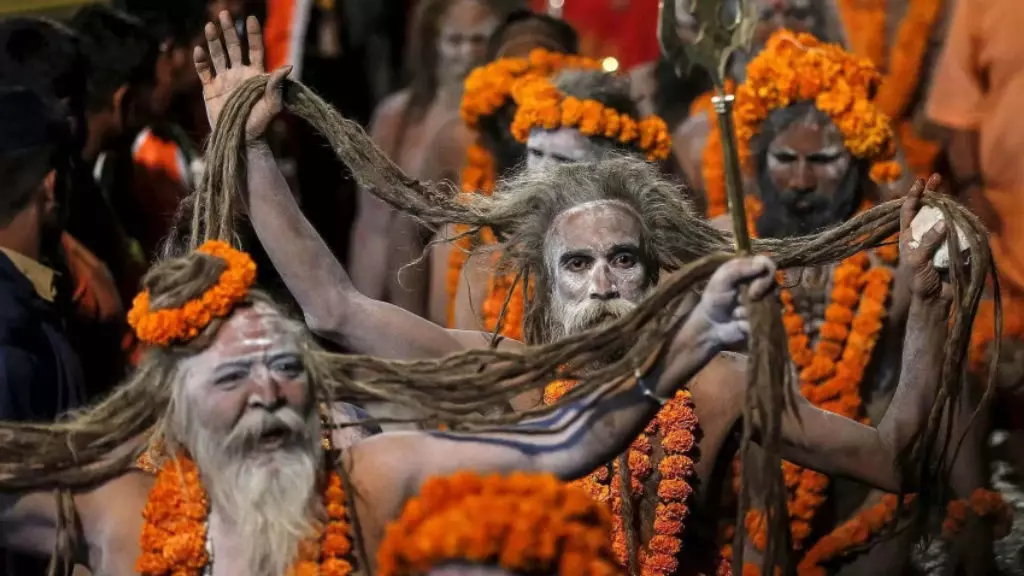
On the first day, the temple doors are shut, marking the beginning of the sacred period. Devotees, sadhus, and spiritual seekers gather around the Kamakhya temple grounds, meditating and waiting patiently. No idol is worshipped here — instead, the goddess is represented by a natural stone shaped like a yoni inside the sanctum.
One of the main rituals involves distributing a piece of red cloth, believed to be soaked in the goddess’s energy during this period. It is considered a powerful blessing. On the fourth day, the temple reopens in a grand celebration called Pravritti. Devotees then rush to seek the darshan and blessings of Kamakhya Devi.
These practices will remain the same in the upcoming Ambubachi Mela 2025. For those who witnessed Ambubachi Mela 2024, this year will again be a spiritual journey of devotion, patience, and belief.
Pooja and Ceremonies
During the Ambubachi Mela 2025 at the Kamakhya temple, the pooja and ceremonies are quite different from usual temple rituals. Unlike regular times, no formal worship or offerings are made during the first three days, as it is believed that Kamakhya Devi is going through her annual menstrual cycle. The temple remains closed, and all rituals come to a complete halt. This pause itself is treated as a sacred ceremony, where nature is given time to rest and renew.
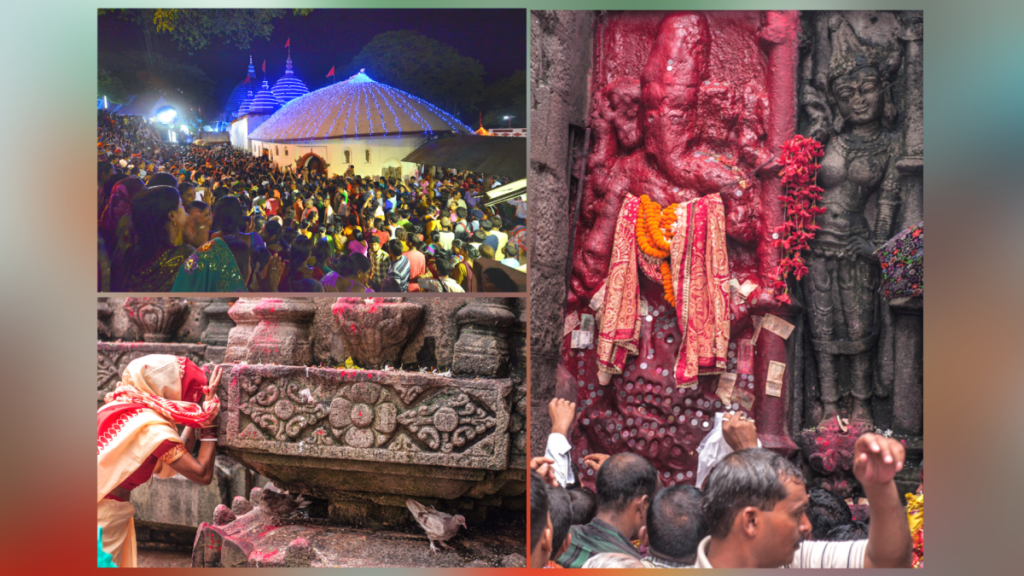
After three days, on the fourth day known as Pravritti, the main pooja begins. The Kamakhya temple doors reopen with great energy and devotion. Thousands of devotees line up for hours to take darshan. Special rituals are performed by the temple priests to mark the return of the goddess from her resting phase. Offerings like flowers, sweets, and red cloth are made to Kamakhya Devi, and the temple complex echoes with chants and prayers.
One of the most spiritual moments is when devotees receive a piece of cloth believed to be blessed by the goddess herself. The Ambubachi Mela 2025 is expected to follow the same pattern as previous years, including Ambubachi Mela 2024, keeping the essence of ancient traditions alive and powerful.
Significance of Mela
The Ambubachi Mela 2025 holds deep spiritual significance for millions of devotees across India. Held at the Kamakhya temple in Guwahati, this mela is not just a religious event but a sacred journey of faith. People believe that during this time, Kamakhya Devi undergoes her yearly menstruation cycle — a symbol of fertility, creation, and the power of nature. Unlike other festivals that involve grand celebrations, this one starts with silence, pause, and patience.
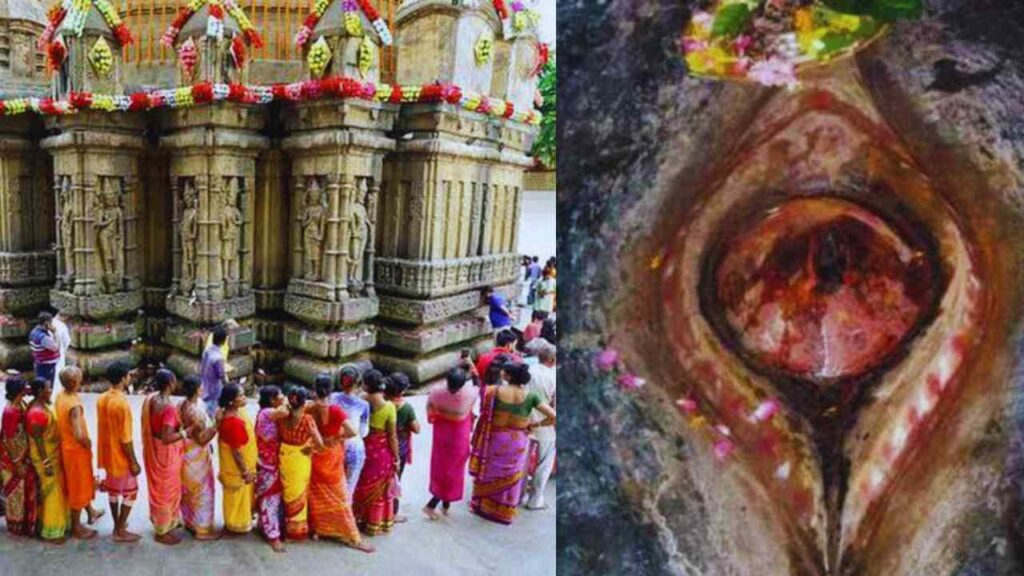
Pilgrims from all walks of life — sadhus, tantriks, common devotees — gather at the Kamakhya temple during Ambubachi Mela 2025 to feel the divine presence of the goddess. For many, just being near the temple is enough to feel spiritually awakened. They wait for days in devotion, without stepping inside the temple, simply to connect with Kamakhya Devi’s energy.
The moment the temple reopens is deeply emotional. It is not just about rituals — it’s about surrender, belief, and a connection to something beyond the physical world. Devotees who experienced Ambubachi Mela 2024 often return year after year, feeling drawn by a spiritual pull they cannot explain. The mela reminds us of the strength of nature, the power of womanhood, and the divine in its purest form.
How to reach Kamakhya Temple
Reaching the Kamakhya temple is easy and well-connected by all major transport modes. The temple is located on Nilachal Hill in Guwahati, Assam. If you’re coming by train, the nearest station is Kamakhya Railway Station, just 6 km away. Guwahati Railway Station is also close, about 8 km. The nearest airport is Lokpriya Gopinath Bordoloi International Airport, around 20 km from the temple. From any of these points, you can hire taxis, autos, or use local buses to reach the temple. A short uphill drive or walk takes you to the main entrance of the sacred Kamakhya temple.
Does the water of the Brahmaputra River turn red during Ambubachi Mela?
Some people believe the Brahmaputra turns slightly red during Ambubachi Mela, but there is no obvious proof. It is said to show the goddess’s menstruation.
Why is the temple closed for 3 days?
The Kamakhya temple stays closed for 3 days because it is believed that Goddess Kamakhya goes through her yearly menstruation during this time
Why is Kamakhya temple sl powerful?
Kamakhya temple is believed to be very powerful because it is one of the 51 Shakti Peethas where the womb of Goddess Sati fell.
What is not done during Ambubachi Mela?
During Ambubachi, farming, cooking non-veg, worship, and reading holy books are avoided, as the earth and goddess are believed to be resting.
What is Ambubachi Mela?
Ambubachi Mela is a special festival held at Kamakhya temple to mark the goddess’s yearly menstruation. Devotees gather in large numbers to seek her blessings.
